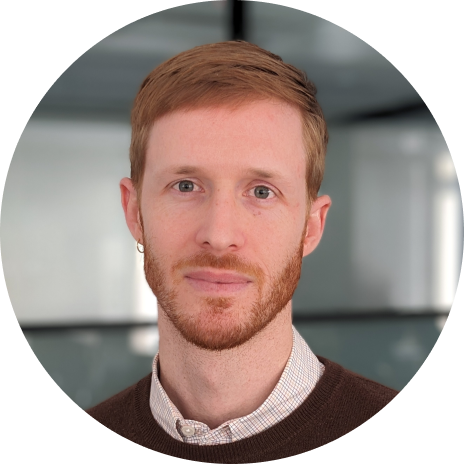Catching up with Christina Ward, Global Transparency Reporting Lead at YouTube.
Luminary Labs’ alumni network comprises more than 100 accomplished individuals — former staff, subcontractors, and close collaborators — now pursuing careers across sectors and industries. Conversations with these alumni consistently reveal the fascinating ways in which they have integrated their talents, backgrounds, and passions to create distinctive professional journeys.
 Christina Ward joined Luminary Labs as an Engagement Manager in 2018. During her tenure, she contributed to numerous projects, over time developing a focus on education. As a Director at Luminary Labs, she led the development of strategic initiatives and designed, launched, and managed multiple innovation programs for the U.S. Department of Education to help adult learners gain math skills, expand career advancement opportunities, and encourage technology education in rural communities. Today, Christina lives in New York and works at YouTube, where she manages global transparency reporting, coordinating the development of recurring public reports that describe YouTube’s performance against community guidelines and regulations.
Christina Ward joined Luminary Labs as an Engagement Manager in 2018. During her tenure, she contributed to numerous projects, over time developing a focus on education. As a Director at Luminary Labs, she led the development of strategic initiatives and designed, launched, and managed multiple innovation programs for the U.S. Department of Education to help adult learners gain math skills, expand career advancement opportunities, and encourage technology education in rural communities. Today, Christina lives in New York and works at YouTube, where she manages global transparency reporting, coordinating the development of recurring public reports that describe YouTube’s performance against community guidelines and regulations.
In this interview, Christina shares some of her favorite Luminary Labs memories and lessons, and reflects on ways she has combined her public policy experience and strategic business perspective throughout her career.
What were some of the most memorable problems that you worked on at Luminary Labs?
I have a few memorable favorites. One of the earliest projects I joined was Power in Numbers, a U.S. Department of Education Office of Career and Technical Adult Education (OCTAE) initiative to help adult learners gain applied math skills. The project was already underway when I joined, but it was gaining momentum as we were moving through the different phases of the project. Our clients were so proud of the work that they asked us to deliver more and more training and conference appearances, beyond the two conferences that we were contracted to showcase the work at. So that was exciting for me. I got to engage with different types of audiences, and that was my first and only time speaking at SXSW EDU.
That work was also super interesting in that it was part of some of the leading-edge thinking in the adult education and career and technical education (CTE) spaces at that time. The Power in Numbers work dovetailed with the Rethink Adult Ed Challenge, another program from the U.S. Department of Education, which was focused on pre-apprenticeships to help adults enter, prepare for, and succeed in apprenticeships and career advancement. Toward the end of my tenure working on CTE programs, we launched the Rural Tech Project to encourage rural high schools and educational agencies to use competency-based distance learning. It was cool to see the Department of Education re-envision career access for rural communities.
What is something you learned at Luminary Labs that you continue to value today?
The nice thing about Luminary Labs is how multidisciplinary the work is — I learned a lot. And because it’s a small team, I benefited from many different ways of thinking and working. I took little pieces from everyone. I would say Jessica Hibbard’s Writing Accelerator has gotten a lot of mileage. I still always think about identifying the audience that I’m trying to communicate to. Julia Lindpaintner, who was on the design team when I first joined, used to send weekly design tips over email. So I learned a lot about design principles through those emails. Julia Wu, who led the communications and marketing function while I was at Luminary Labs, taught me the “think, feel, do” framework. I later learned that this is a fairly common framework, but I had never encountered it before, and it really changed the way I think about communication. And Sara delivered a great “Strategy 101” session that I continue to reference. She opened it by emphasizing the importance of defining objective, strategy, and tactics — in that order. There’s a reason that part got a big red underline in her deck, and I use that framing with my team frequently today. It’s a reminder that a lot of really smart folks need help to frame all of the great work they’re doing.
Do you have a favorite Luminary Labs memory?
I really enjoyed and still remember the “meeting of the minds” and kickoff meetings we hosted with our clients. These meetings were so inspiring because of the brain trust we created; I love seeing so many diverse ways of thinking bent toward a single aspiration. A few of my favorite ones were for CTE Mission: CubeSat and MagQuest.
What are you working on right now?
I lead global transparency reporting for YouTube, where I coordinate all public recurring reports describing our performance against our community guidelines or regulations. It is a pretty wide mandate, but we try to draw the boundaries around it. There’s plenty of gray area and we work very closely with sister teams around the company to accomplish our mission.
This is my second role at Google. The last role that I held was also in an intersectional role that blended business and public policy, which reflects my academic and professional background. I studied public policy as an undergrad and then I got my MBA. I think the work I did at Luminary Labs also underscored that intersection — I brought my business perspective to our work with government clients. I think my ability to be bicultural in that way is helpful in a cross-functional role where you have to work with both government affairs and business leaders.
What’s the most exciting thing about your current role?
The diversity of disciplines represented on my teams is most exciting. I manage a brilliant group of program managers and they all essentially have to serve as cultural translators between the lawyers and the engineers, the product teams and the analysts, the government affairs folks and our leadership committee. And while we all have a common goal, everyone is optimizing for something slightly different. The challenge is in converting that into something that can be packaged up into a clean system with clear processes and results that we can then communicate to the rest of the world. It’s not always easy, but it’s always interesting.
We’d love to hear about an underrated issue, trend, or innovation you care about — what’s on your radar, and what do you wish more people were thinking about?
Well, my answer may not be exactly what you’re expecting because I wouldn’t call generative AI under-hyped, but I think it is underutilized still in fundamental research. I don’t hear as much as I would’ve expected about academics using tools like NotebookLM or Gemini Deep Research to develop interdisciplinary perspectives or to iterate more rapidly on scientific discovery.
We love recommending books, articles, podcasts, videos, etc. to our network. Is there something you’ve read or seen or listened to lately that you would really want others to know about?
I listen to a lot of podcasts. One that I listen to every week to get the latest tech news is Hard Fork from the New York Times. For moments where I am just feeling more curious about the world, I like Radiolab, which is more about discovery and science. It usually starts with the simple question, “why does this happen the way it does?” I’ve also been thinking more about spirituality and listening to Elizabeth Oldfield. She has a podcast and a book that I’ve been listening to. The book’s called Fully Alive and the podcast is called The Sacred.
Tell us about something that brings you joy.
My zany toddler brings me so much joy. He’s playful and imaginative and super engaged.


